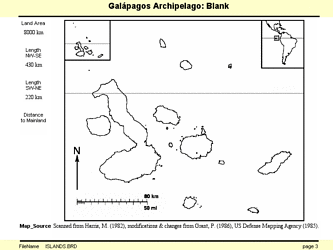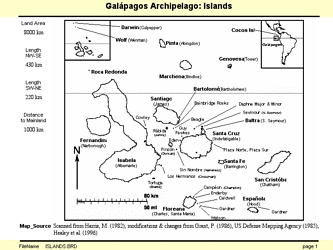The Galapagos Finches are one of the most widely recognized examples of research in evolutionary biology. This treehouse provides access to a variety of data resources that can be used to think about the causes and relationships underlying the distribution and other characteristics of the Galapagos Finches. The materials featured on this page come from an NSF funded educational project called Beagle Investigation Returns with Darwinian Data (BIRDD). You can learn more about BIRDD at http://www.bioquest.org/birdd/index.php.
Overview
Below you can see that I have attached a couple of maps of the archipelago (one with and one without labels) and some data about the islands and distribution of the finches. In class I use materials like these to get the students to start looking at patterns in the data that might help them understand what is going on. Sometimes I give them acetate sheets with the blank maps printed on them and overhead pens so that they can represent a pattern from the data sheets directly onto the spatial representation of the islands.
Interesting Questions to Investigate
- Do you see different types of patterns when you look at different scales or resolutions? For example, try dividing the archipelago into 4 quadrants and looking at the distributions within each. Or, try mapping genera instead of species. What does it look like if you make island categories of small, medium and large?
- Are there features that seem to correlate with the presence or absence of particular species? Which species are most likely to be found together?
- Find a phylogeny of the finches and see if that information is useful in explaining what you have observed.
Materials
Galapagos Archipelago blank map
Click here for a full size image  View island_names1.gif
View island_names1.gif
Galapagos Archipelago labeled map
Click here for a full size image View island_names1.gif
View island_names1.gif
Table of island features
Table of finch status
 View finch_status.pdf
View finch_status.pdf







 Go to quick links
Go to quick search
Go to navigation for this section of the ToL site
Go to detailed links for the ToL site
Go to quick links
Go to quick search
Go to navigation for this section of the ToL site
Go to detailed links for the ToL site